I'm thrilled to share with you an extraordinary experience: a week in Mandalay, Myanmar, shooting a video for Leica Camera documenting Steve McCurry as he uses the brand new Leica SL3.
Mandalay proved to be an inexhaustible source of inspiration. The streets teeming with life, the colorful markets, the majestic temples: every corner told a story. I had the privilege of immersing myself in a rich and fascinating culture, meeting extraordinary people along the way.
The dawn light on golden temples, the vibrant colors of traditional textiles, the intense flavors of local cuisine, the mystical atmosphere of monasteries: each day brought new wonders to capture with the camera.
The Leica SL3, Steve's camera of choice for this project, is a powerful tool for visual storytelling. At its heart lies a 60-megapixel full-frame BSI CMOS sensor, capturing exceptional detail and dynamic range. The Maestro IV image processor ensures lightning-fast performance, allowing Steve to react swiftly to fleeting moments. The hybrid autofocus system combines contrast-detection and phase-detection for accurate focusing, even in challenging lighting conditions. The SL3 also boasts impressive video capabilities, recording up to 8K resolution for stunning cinematic results.
I wasn't just documenting Steve, I was also using the SL3 myself to capture the beauty and energy of Mandalay. The camera's exceptional image quality and high-resolution video capabilities proved to be invaluable. I particularly appreciated the camera's ability to shoot in 4K at 60fps, allowing me to capture smooth, slow-motion footage of bustling markets and vibrant street scenes.
For the project, I primarily filmed in 4K at 30fps, ensuring clean and detailed visuals. The 10-bit 4:2:2 color profile provided ample room for color grading in post-production, allowing me to achieve the look I envisioned. The Leica SL3 proved to be a versatile and reliable companion, perfectly suited for the demanding conditions of travel filmmaking.
My deepest gratitude to Leica Camera for offering me this unique opportunity, and of course, a special thanks to Steve for sharing his work.







